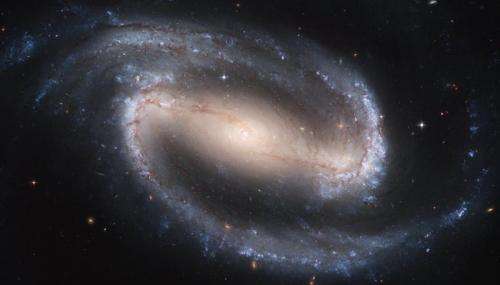Hubble and Galaxy Zoo find bars and baby galaxies don't mix

(Phys.org) —Harnessing the power of both the Hubble Space Telescope and the citizen science project Galaxy Zoo, scientists from the University of Portsmouth have found that bar-shaped features in spiral galaxies accelerate the galaxy aging process.
The astronomers found that the fraction of spiral galaxies with bar features has doubled in the last eight billion years – the latter half of the history of the universe. The scientists publish their results, the first from the Galaxy Zoo: Hubble project, in the journal Monthly Notices of the Royal Astronomical Society.
University of Portsmouth postgraduate researcher Tom Melvin led the new study as part of his thesis work. He and the rest of the Galaxy Zoo science team used classifications provided by citizen scientists to select spiral galaxies across the Universe for the study. Light from the furthest galaxies has taken eight billion years to reach us, so we see them as they appeared eight billion years ago or when the cosmos was a little over half its present age. This allows astronomers to study how the characteristics of galaxies change over this time.
Many galaxies with spiral shapes (like the one we live in, the Milky Way) also have central bar-shaped features. These structures are made up of stars and the spiral arms extend from the ends of the bar.
Mr Melvin's group studied how the fraction of spiral galaxies with bars changed over time. They found that 8 billion years ago only 11% of spirals had bars, but by 2.5 billion years ago this proportion had doubled. In the present day universe two-thirds of galaxies have bars. And the more massive the galaxy, the more likely this is to be the case.
Mr Melvin comments: "This is a really interesting result which has been made possible by the contributions of citizen scientists, who yet again are helping cutting edge astronomical research when they spend time classifying galaxies at Galaxy Zoo."
The new work also confirms that bars signify maturity for spiral galaxies and may play an important role in switching off the formation of new stars. For some of the most massive spiral galaxies, this happened relatively early in the life of the universe.
Dr Karen Masters, also from Portsmouth University, and Project Scientist for Galaxy Zoo said, "It looks as though bars really are bad for spiral galaxies. As a bar grows in a galaxy, it is less likely to have any new stars being born and the galaxy settles down to a sedate maturity."
More information: Thomas Melvin, Karen Masters, Chris Lintott, Robert C. Nichol, Brooke Simmons, Steven P. Bamford, Kevin R. V. Casteels, Edmond Cheung, Edward M. Edmondson, Lucy Fortson, Kevin Schawinski, Ramin A. Skibba, Arfon M. Smith, and Kyle W. Willett. "Galaxy Zoo: an independent look at the evolution of the bar fraction over the last eight billion years from HST-COSMOS." MNRAS. January 16, 2014 DOI: 10.1093/mnras/stt2397
A preprint is available from arxiv.org/abs/1401.3334
Journal information: Monthly Notices of the Royal Astronomical Society
Provided by Royal Astronomical Society




















